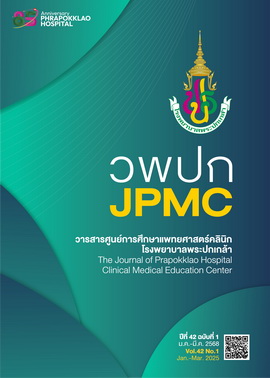Chili
Main Article Content
Abstract
Chili belong to the SOLANACEAE family and contain active compounds that provide their spiciness, specifically capsaicinoids, including capsaicin, dihydrocapsaicin, nordihydrocapsaicin, homodihydrocapsaicin, and homocapsaicin. Capsaicin is the primary compound in the capsaicinoid group, with pharmacological effects that include anti-inflammatory properties. Currently, formulations such as gels, creams, and ointments containing extracts from dried chilli (Capsicum annuum L., Capsicum frutescens L.) have been developed, with a concentration of capsaicin at 0.025%. These products are suitable for relieving joint pain and musculoskeletal pain.
Article Details

This work is licensed under a Creative Commons Attribution-NonCommercial-NoDerivatives 4.0 International License.
References
Smitinand T. Thai plant names. 2nd ed. Bangkok: Forest Herbarium; 2001.
Phokawattana C. Chili. Kaset kao na 1997;12(2):1-40.
Sayamanon J. HPLC analysis of capsaicin in Huey See Ton chilli. In: The 23th Kasetsart university annual conference. Bangkok: Kasetsart University; 1985. p. 19-27.
Sukchum N. Changes in capsaicinoid during product development process of chili powder [dissertation]. Pathum Thani: Rangsit University; 2020.
National Drug Committee. National List of Essential Medicines [Internet]. 2013 [cited 2024 Apr 13]. Available from: https://ttm.skto.moph.go.th/document_file/pr008.pdf#page97
Sombutaree M. Extract of capsicum placenta in gel form for muscular pain relievers using d - phase system [dissertation]. Pathum Thani: Rangsit University; 2021.
Autayakool K, Suethanapornkul S, Teeranet G. Efficacy of topical capsaicin and methyl salicylate as an adjuvant therapy in chronic non-specific low back pain treatment: a comparison study. ASEAN Journal of Rehabilitation Medicine 2007;17:91-5.
Sahaworakulsak R, Pitiporn S, Musikawong N. The efficacy of capsicum cream apply externally once a day on knee osteoarthritis in patients. Prachin Buri: Chaophya Abhaibhubejhr Hospital; 2016.

